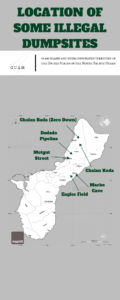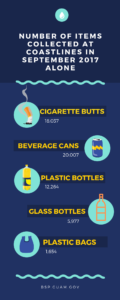In 2017, Guam welcomed close to 1.3 million tourists, who arrived mostly from Japan and South Korea, according to the Guam Visitors Bureau’s 2017 annual report.
These visitors sought to enjoy the beautiful views of sunsets, beaches, and other scenes Guam has to offer. Some of the more adventurous tourists rent cars to drive around the island, seeing the symptoms of the problem of illegal dumping.
Those who choose to visit Guam’s nature spots such as One Thousand Steps at Fidian Point or Marbo Cave may be welcomed with piles of trash at the entrance or alongside the trails.
“Illegal dumping is not just a Guam thing,” said Nicholas Lee, public information officer of the Guam Environmental Protection Agency.
Although efforts such as the Coastal Cleanup and other non-profit organizations which help with trash around the island, the problem continues, especially in low traffic areas.
“It’ll take an island-wide effort,” Lee said. He also mentioned that the reasons why residents choose to dump illegally vary, and range from the inability to afford services from Guam Solid Waste Authority to having a lack of knowledge regarding the consequences of illegal dumping.
According to Australia’s Environment Protection Authority , when people dispose of their trash improperly, they not only harm the environment but also create more hazardous issues “when hazardous chemicals are involved, they can harm the environment by polluting land and waters.”

Waters that include the sea, rivers, and drinking wells such as aquifers are part of areas that are polluted.
Since the Northern part of Guam receives its water from aquifers, it is vital that the people of Guam do their best not to pollute it.
Residents of Guam can opt to receive services from GSWA, which cost about $30 per month, or at least $7.50 at the transfer station according to GSWA’s website.
There are currently three transfer stations located in Harmon, Agat, and Molojloj, which are open from Thursday to Monday from 9 a.m. to 5 pm.
To some, $30 can add up making it difficult to keep up with payments thus resorting to illegal dumping. Some residents simply cannot afford another bill added to their monthly budget.
If their debris leak into Guam’s aquifer this can lead to more serious issues.
With Guam receiving more than 80% of its goods or $1.11 billion in imports in 2017, the possibility of losing its water sources will only add to the cost of imports according to the Observatory of Economic Complexity, a source used to track international trade data.
GEPA plays an “enforcement role,” Lee said.
Some penalties GEPA issues to individuals who illegally dump include a minimum fine of $200 and a maximum of $1000.
“We’ve seen other jurisdictions increase penalties and harsher fines.”
Social media and the community help GEPA with catching those who break the law, but increasing fines or using technology can only do so much unless a change of mentality is set in place.
People need to take pride in where they live. With tourists that have spent millions of dollars each year to travel to Guam, it only gives us more reasons to keep Guam clean.
The tourist industry provides jobs, promotes local businesses, and allows Guam to reach larger markets. If the problem of trash continues to grow, more tourists will take notice and with the power of social media have a negative effect on the number of people who travel to Guam.
In September 2018, the annual Coastal Cleanup “collected over 36,000 lbs of waste” according to an article on the Pacific Daily News. Imagine the amount of waste not collected further inland.
Trash that is left on the beach can easily be washed into the oceans directly affected marine life.
Fish might mistakenly eat small particles of plastic, the material used to hold a 6 pack of beer can easily wrap around a turtle’s neck, and etc.
According to the Joint Research Center of the European Commission (JRC), “global demand for seafood destined for human consumption is 143.8 million tonnes per year.”
With illegal dumping, harsh chemicals can leak into the ocean and contaminate a whole chain of fish.
If the fish are contaminated and we eat them without knowing, “this can result in dangerous health problems, which include hormonal issues, reproductive issues, and damage to our nervous systems and kidneys,” according to Planet Aid, a non-profit organization that helps protect the environment and supports sustainable development.
Concerned citizens also want the Government of Guam to do more in resolving the issue of trash.
With GEPA issuing citations which plays as a compliance role, more resources like money and manpower are needed.
It very crucial that Guam prevents the issue of illegal in the first place.
Public service announcement, educational outreach, and related programs can help educate people with information that can help with their decisions regarding trash.
Would you like a cup of toxic waste to go with your dinner? How about the amazing view of garbage at the entrance of your planned hike this weekend? Think of all the illegal dump sites around the island. Abandoned cars, bags full of trash, and tires all tossed on the side of the road and even at the entrances of hiking spots such as Thousand Steps. Physical deterrences, non-profit organizations, and other sources allow Guam to further solve the issue of illegal dumping.
Short-cut solutions to disposing trash only create long-term problems for the rest of the island. Everyone needs to be accountable for their actions and the authorities need to put more pressure on the people who commit these crimes.
Throwing garbage on the side of the road may not be as dreadful as a robbery, but it only gets worse the more we turn a blind eye to it. Currently, the Guam Environmental Protection Agency uses fines to punish those who are caught illegally dumping.
One might argue that it forces people to pay the minimum $7.50 at one of the transfer stations, but it also sends a message that those who can afford to pay the fines can continue illegally disposing their trash.
Some Guam residents have lost their respect for the island and need to be taught a lesson or two of the disrespect they have caused.

Modulo, a company aimed to reduce illegal dumping, offers an illegal dumping prevention guide that includes site maintenance and controls, community outreach and involvement, targeted enforcement, and program measurement.
Modulo suggests dumping prevention programs that involve the community which offer free disposal for small residential waste loads.
Volunteers monitor high frequent dumping areas who aid in reporting illegal dumpers. In addition to GEPA’s fines or punishments, they can add vehicle impoundments, revocation of driver’s license or permits, or community service.
“Guam Solid Waste Authority has services where you’re able to dispose of household items, said Nicholas Lee, public information officer of GEPA. “They do provide curbside pickups. These are services that are needed to be scheduled in advance.”
The officials who issue citations need the public’s support as well as the support of their agency to receive additional training that’ll make their jobs more efficient.
The Environmental Protection Authority website provides four illegal dumping prevention mechanisms: make illegal dumping harder, increase the risk of getting caught, reduce the rewards by denying the financial benefits, reduce provocation by making legal disposal easier, and remove excuses by educating and informing the community.
Barriers, lighting and barricades are used to make hot spots for illegal dumping much harder to access. When people are educated through outreaches or public service announcements, they more aware of the consequences and resources available to them.
Since October 14, 1995, Guam has joined the worldwide effort to prevent pollution. Every third Saturday of September, volunteers for the Guam Coastal Cleanup take part in cleaning the coastlines of Guam’s beaches.
According to the Guam Coastal Management Program, about 36,266 pounds of trash were collected in comparison to 20,038 pounds of trash in 2016. The most collected item for both years included beverage cans and cigarette butts.
It is important to note that this data only considered the amount of trash where the coastal cleanup took place and does not include inland sites.
The rise of collected trash is an indicator of an increase of illegal dumping. With that in mind, the amount of trash not accounted for, especially in hot spots for illegal dumping inland, far outweighs what was measured.
The people who illegally dump are not only your next door neighbors, but also include companies and businesses.
GEPA’s website includes a list of those companies and businesses who were caught improperly disposing waste or were not in compliance with GEPA regulations.
As of April 4, 2019, Ben ‘N Yan Mini Mart & Washland, Asanuma Corp & Nippo Guam USA, Inc., and Coco Palm Resort were all recently cited for violating GEPA regulations, according to GEPA’s website.
Anyone can report a person or business who had violated GEPA regulation by filling out a form on the GEPA’s website, which includes the description of the activity, location/address, and the responsible party.
We all have the responsibility to look out for one another whether it be to properly dispose trash or to remind others of the consequences for not doing so. Guam gets its drinking water from the aquifers and once that is contaminated we will have a very difficult time looking for an alternative water source.
The whole island needs to see the bigger picture of what this problem has caused and act on it now. Violators should be held accountable under any circumstance.
Countries like the Philippines have a trash problem that is unfortunate and difficult to reverse according to BBC new article, “Rodrigo Duterte: Philippines not a ‘dump site’ for Canadian waste.”
Let us learn from others so that we do not repeat the same mistakes they did.
The University of Guam’s Center for Island Sustainability has mentioned that Guam can only have so many landfills until we have to pay to export our trash. The buildup of trash around the island may only be an eyesore now, but later will develop into something much worse.
